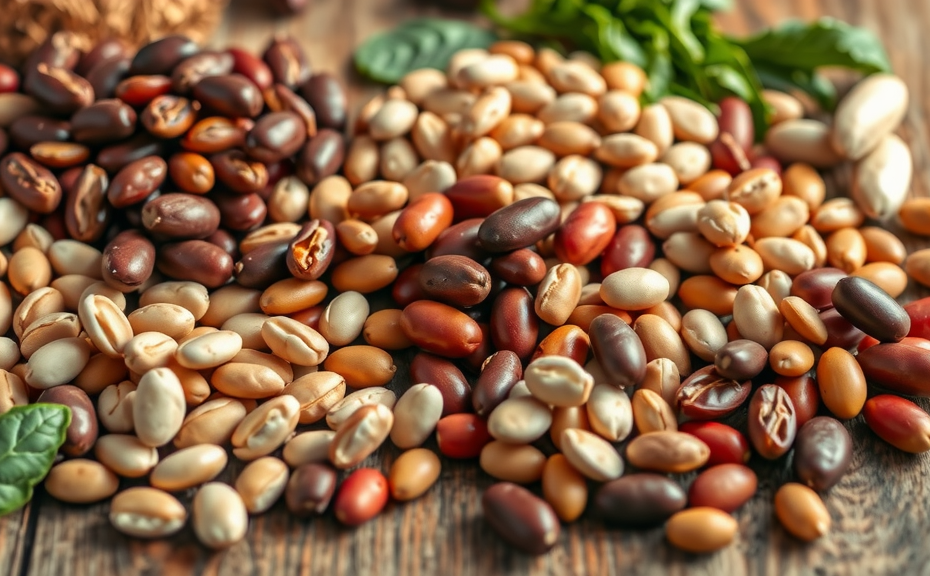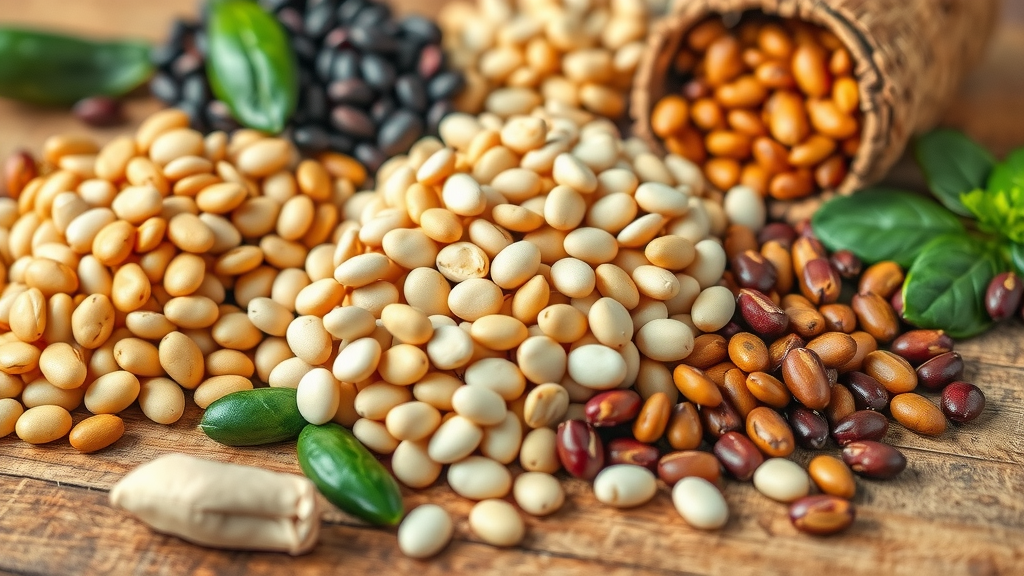When it comes to a healthy diet, few foods are as versatile and satisfying as beans. These little legumes are packed with impressive nutritional value, making them a favorite choice for many.
While they’re often celebrated for their plant-based protein content, you might be curious about whether they can fully meet your protein needs.
To get to the bottom of this, let’s explore the role of amino acids in our diet.
Beans are rich in many essential amino acids, but they don’t provide all of them in the right amounts.
This means they serve as an excellent source of plant-based protein, yet to achieve a complete protein profile, they might need some assistance from other foods.
Are Beans Complete Proteins
When it comes to nutrition, beans are often celebrated for their many benefits. But if you’re looking to maximize your protein sources, it’s important to note that they don’t provide a complete set of amino acids by themselves.
This means they can be missing some of those essential amino acids your body needs.
But hey, no need to fret! Pairing beans with grains like rice or quinoa can create a well-rounded meal that covers all your dietary protein needs.
It’s especially handy for those following a vegetarian diet. So while beans might not hold the title of a complete protein alone, they’re still a worthy addition to your plate.
Just think about how delicious it is to mix them with your favorite grains for a fulfilling dish.
Understanding Amino Acid Profiles
Let’s dive into the fascinating world of proteins and how they contribute to our health. Amino acids, often referred to as the building blocks of proteins, play a significant role in muscle growth, repair, and overall wellness.
When looking at protein sources, you’ll find some, like soybeans, are complete, meaning they provide all essential amino acids your body needs.
Others, like many beans, are not quite as effective alone.
This is where complementary proteins come into play; by pairing foods like beans with grains, you can create a more balanced amino acid profile.
How we cook our legumes can also influence how well our bodies absorb these important nutrients. For instance, lentils come packed with unique amino acids that can enhance their nutritional profile, but proper preparation is key. When discussing sources of vegan protein, soybeans, lentils, chickpeas, and quinoa are some of the most nutritious options.
Proteins and Health
- Amino acids are essential for muscle growth, repair, and overall wellness.
- Complete protein sources, like soybeans, provide all essential amino acids needed by the body.
- Complementary proteins, such as pairing beans with grains, can enhance the amino acid profile of meals.
- Proper preparation of legumes, like lentils, is crucial for maximizing nutrient absorption.
Health Benefits Of Legumes
Adding nutritious foods to your meals can be both easy and delicious. Those little powerhouses bring a ton of benefits to the table, making them a perfect fit for any diet.
Packed with protein quality, they offer a fantastic range of nutrients to keep you feeling your best.
For example, they’re high in fiber, which is fantastic for digestion.
You can mix up various food combinations to enhance your meals’ nutritional value. When paired with grains, they support muscle building by providing essential amino acids.
If you’ve been worried about protein deficiency, simply incorporating these into your meals can help you meet your needs without breaking the bank.
Protein Quality In Plantbased Diets
Exploring plant-based options opens up a world of flavors and nutrients. Protein plays a significant role in maintaining your body’s health benefits, so getting enough from these sources is a great idea.
For adults, aiming for about 46-56 grams daily is a good target.
But there’s no need to stress; it’s totally achievable with a variety of tasty plant foods!
Legumes, nuts, and seeds shine as fantastic sources.
They deliver not just protein but also dietary fiber, which keeps your digestion running smoothly. For example, combining foods like rice and beans can really boost protein absorption.
With a sprinkle of creativity in the kitchen, you can whip up delicious meals that benefit your overall health while savoring the goodness of these ingredients.
| Food Source | Protein Content (per 100g) | Additional Nutrients |
|---|---|---|
| Black Beans | 21g | Fiber, Iron, Folate |
| Chickpeas | 19g | Fiber, Manganese, Phosphorus |
| Almonds | 21g | Vitamin E, Magnesium, Healthy Fats |
| Quinoa | 4g | Fiber, Iron, Magnesium |
Meal Planning With Beans
Discovering new ingredients to include in your meals can bring exciting flavors to your table. Not only do legumes provide cost-effective protein, but they also fit within nearly any budget.
Their versatility shines through in a variety of dishes, from hearty soups to refreshing salads.
Plus, they are loaded with antioxidants, which support your body in various ways.
Mixing different legumes, like black beans and lentils, ensures a broader spectrum of nutrients that are great for heart health. Planning meals around these nutritious foods not only saves you money but enhances your overall diet. Give these legumes a try, and you’ll see just how easy meal prep can be! Transitioning from protein quality in plant-based diets, it’s clear that understanding how to combine foods for optimal nutrition is just as essential—stay tuned for some great tips on that, including the benefits of antioxidants, sustainable and cost-effective protein sources, and options that are gluten-free and good for heart health.
How To Combine Foods For Nutrition
Mixing different foods can really elevate your mealtime experience while boosting your overall health. Focus on how various food categories can work together, especially when incorporating protein alternatives into your meals.
Take beans and rice, for instance; they’re a classic combo that not only tastes great but also offers a complete protein source.
Don’t shy away from adding vibrant herbs and spices to your dishes—they can transform a simple meal into something truly delightful.
During meal planning, consider tossing together chickpeas and quinoa in a salad, as this blend brings impressive nutrient density to the table. Enjoying your meals is so important for building and maintaining healthy eating habits.
Now, as we venture into dietary recommendations for protein intake, let’s explore how to ensure your meals are both nutritious and satisfying.
Dietary Recommendations For Protein Intake
Getting your protein just right can feel like a puzzle, but finding the right balance is totally achievable. Your needs can vary depending on factors like age, activity level, and overall health.
Tailoring your protein content to fit your lifestyle is super important.
Not all sources deliver the same benefits, so it’s a great idea to prioritize high-quality options.
By mixing different sources, you’ll create a balanced amino acid profile, which translates to healthier and more satisfying meals.
Incorporating more plant-based foods into your routine can significantly boost your protein intake. Think about adding legumes, nuts, and seeds to your meals! Timing can also play a vital role in your approach.
Strategically spacing out your high-protein meals throughout the day can enhance overall wellness, making you feel energized and satiated.
Before diving deeper, it’s essential to consider how protein intake and amino acid profile can influence your overall health, particularly when incorporating high-protein meals that provide complete nutrition and optimal protein content.
.
Common Misconceptions About Protein Sources
Protein comes from a lot of places, and it’s not all about meat; embracing food diversity opens up a world of options. For instance, legumes and grains pack a protein punch and provide essential amino acids, which can really shake up the old belief that only animal sources can deliver complete nutrition.
Some folks assume all protein sources are created equal, but that’s not quite the case.
Knowing which options support healthconscious eating can make a difference in your overall well-being.
By combining various sources, you can optimize your intake and create balanced meals that satisfy your nutritional needs. So, why limit yourself? Dive into the delicious variety of protein sources available for health-conscious eating, food diversity, and effective energy sources to support weight management and balanced meals!.
Protein Sources
- Legumes and grains are excellent sources of protein and provide essential amino acids.
- Plant-based protein sources can contribute to a balanced diet and overall well-being.
- Diverse protein sources can enhance meal satisfaction and nutritional variety.
- Combining different protein sources can optimize nutrient intake and support weight management.

